How to fly your drone safely in winter
In winter, snow and frost transform the landscape into a winter wonderland. A great time to explore the world from above. I invite you to join me on my winter flights in Iceland and the Netherlands. Enjoy the sights and read about flying a drone at freezing temperatures and the precautions you should take.
This tutorial is written by Paul Oostveen. Previous versions of this tutorial have been published at the websites of Skypixel (2017) and Natuurfotografie.nl (2018, in Dutch). These other versions together got 59.000 views up to December 2023.
Snaefellsjökull and Stapafell mountains on the peninsula Snaefellsnes in Iceland. This is a 360° panorama, stitched from dozens of photos. You can move around in all directions and zoom in or out with your mouse or fingers.
Flying a drone in frost: be careful
When flying during frost, the risk of problems arising may be higher and battery performance will be reduced. The photos on this page are made with temperatures between -13°C and +3°C (8-37°F). I flew without any problems and many other drone pilots have been flying during frost as well. However, you should take your precautions and consider using a drone recommended for frost.
I made dozens of flights during frost in Iceland as well as in the Netherlands and experienced no major problems at all. Nevertheless, in frost I’m even more cautious than in summer, checking everything one more time, avoiding flying over buildings or people and returning well before my battery gets empty – as well as taking the other precautions written below. I always place my drone (but not yet the batteries) outside my car, building or bag for a few minutes before I start the engines. This helps to acclimatize and prevent condensation during flight.

Frozen floodplains along the river IJssel. The floodplains were submerged during high water, then frozen and finally covered with snow.
Coastline and lakes
I love water: it’s great to photograph lakes, rivers and the coastline from the air. In winter lakes may be frozen and can display amazing patterns. The coastline is another great place to photograph when the land is covered with snow.
Exposure and filters
When photographing snow, double-check your exposure as the automatic exposure may be wrong if most of the landscape is white. In most cases you should overexpose to give the snow its natural light color. If you have a lot of contrast (e.g. against the sun) you can use exposure bracketing (making a series of photos with different exposures). Afterwards you can merge the different photos together or select the photo that turned out to be the best exposed one. Snow in the shadow is often a bit blue colored. You can change the white balance (in some cases only for the shadow parts) to correct the blue shades.
Tiny pieces of snow (as well as ice and water surfaces) can give a lot of reflections. I recommend a polarizer filter for your camera to prevent these reflections and improve the colors. For video, a combined ND-polarizer is recommended to achieve the optimum shutter speed as well (twice the frame rate, so 1/60 sec if you shoot at 30fps). PGYTech, PolarPro and Freewell sell polarizer and ND-PL filters for many different drones.

Winter beach in Snaefellsnes, Iceland.
Drone batteries
Batteries for your drone as well as smartphones/tablets don’t like low temperatures. I keep them warm as long as possible or use a hand warmer to heat them up a bit. The DJI apps warn me if a battery is colder than +15°C (59°F) . In that case, I try to heat them by hand or start the engines without taking off to warm them up. In winter it’s always a good idea to start your flight by hovering the drone just in front of you for about a minute to further warm up the battery and check the behaviour of the drone. If I make two flights right after another, I use the warm battery of the first flight to heat up another battery by holding them together for a few minutes (within my gloves). Remember that flight time is often less in colder temperatures, so it is a good idea to check the battery level frequently and to return your drone earlier than you would do in summer. I always planned my flight to make the last photos close to the place where I was standing. Strong winds will affect your battery life as well. The batteries in your controller also use power faster in cold, so protect the controller as well.
Smartphones and tablets
Most smartphones and tablets will enter a safety mode when getting too cold. This results in a black screen, so you may lose your live view and flight parameters. When I still used my phone together with my standard controller, I kept it warm as long as possible and I always used a sunshade hood around my smartphone in winter. It gives a clearer view but also gives some protection against the cold wind. However, it's safer to use a screen that can handle the cold, like the built-in screen of the DJI RC Pro or a rugged tablet like the DJI Crystal Sky (unfortunately not compatible with recent drones) or the Tripltek 8 Pro (suitable for 0°-120°F or -18° to +50°C).
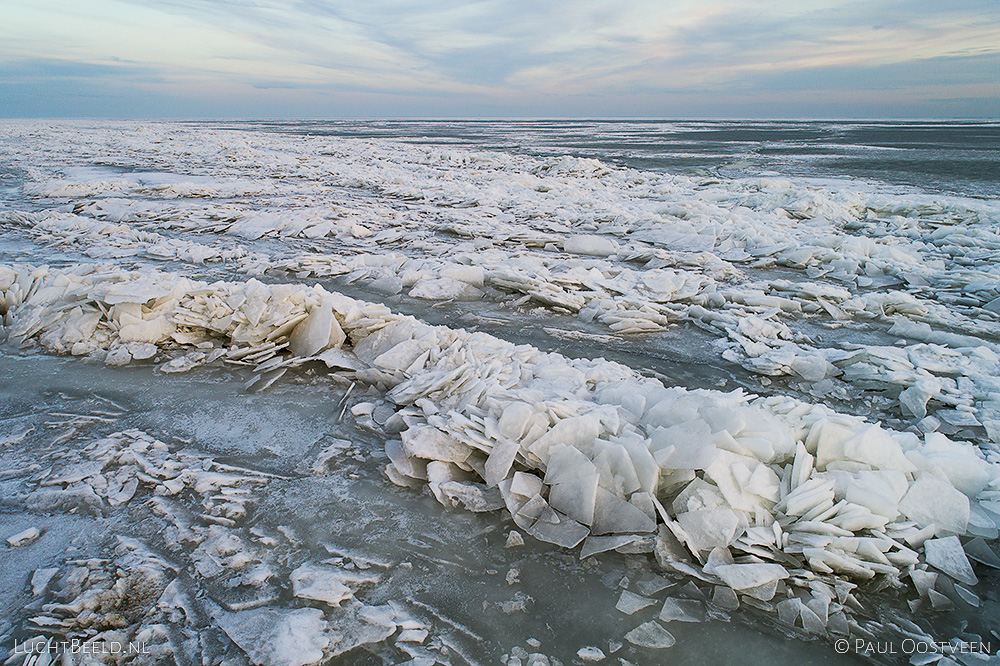
Ice shove in Markermeer, Netherlands. After a long period of frost the ice of big frozen lakes can slide over each other when it starts to thaw.
Long exposure waterfalls
With long exposure you can blur moving objects (like flowing water in a waterfall) while stationary object like rocks or ice remain sharp. With moving water this gives a kind of mystic or serene effect. I use a ND filter to achieve long exposure times (of a few seconds) during daylight. This photo is taken just before sunset with a 4 stop filter (ND16). Long exposure is a great technique to apply during winter flights with still moving water. For more information about using filters for long exposure photography, read my tutorial Long exposure by filter.
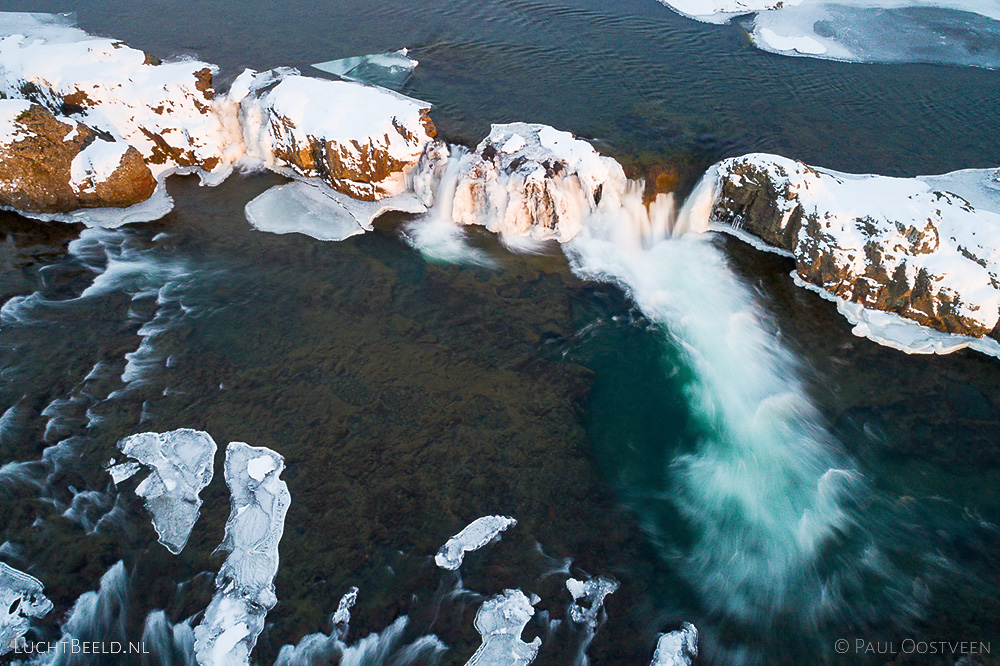
Tröllafossar waterfall in winter.
Icing on the propellers
Flying a drone in rain or snow showers is not recommended, as drones don’t like water and it will blur the lens. But in winter there is another danger: icing on the propellers. With temperatures below (or just above) freezing point, water droplets (from fog, sleet, rain or low clouds) may freeze immediately when they touch any object, especially the fast turning propellers. The extra weight and irregular forms of the ice may make it impossible to control your drone. You should be extremely careful when frost and high humidity occur together. If you notice any irregular behaviour or receive a message about gimbal overload, immediately land your drone and inspect the propellers. Remember that the gimbal will try to compensate irregular movements, so watch not only the live view but also your drone in the air. Fog may also disrupt GPS reception or trigger the obstacle avoidance sensors.
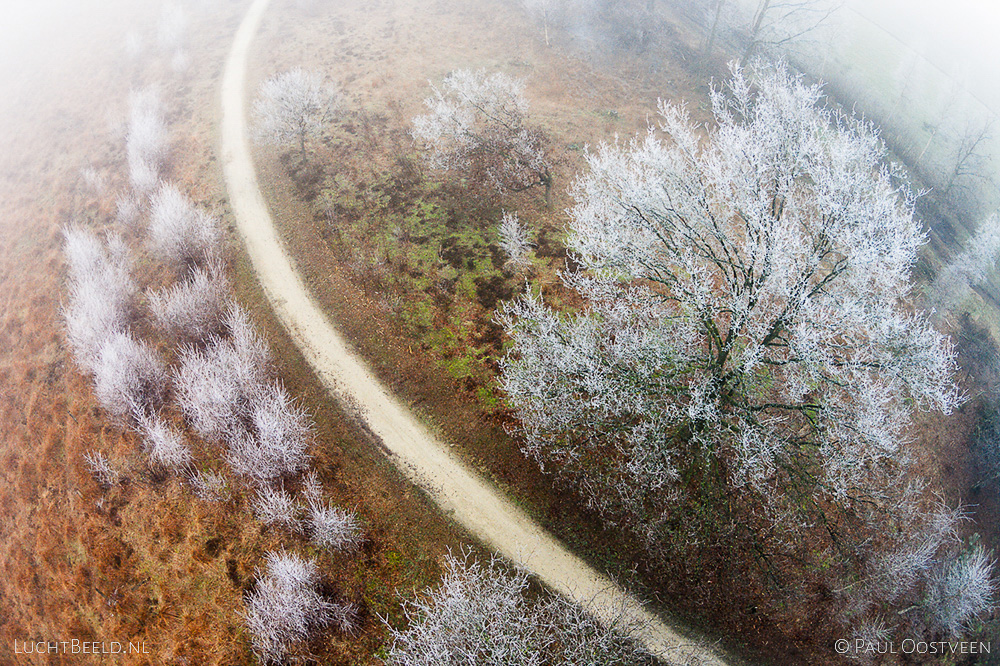
Frost on trees is very photogenic, but watch out for icing on your propellers.
(360°) Panoramas
Winter landscapes are great for making panoramas of several photos or even 360 degrees panoramas. Composition may not be the first thing you think about when making a panorama all around (as you cannot frame your shot), but you can influence it for sure by choosing the right place, altitude and time (position of the sun, weather). For many more tips about 360° panoramas, read my tutorial about aerial 360 degrees panoramas (available soon). DJI Fly and DJI Go now can create panoramas automatically, but I still prefer to make them manually to achieve the best results in exposure and detail. In winter, sun is standing low above the horizon resulting in a high contrast between the side where the sun stands and the other side. I always ensure a balanced exposure of all individual photos for the best result all around. At the top of this page, you see a 360 degrees panorama of Snaefellsjökull in Iceland. More panoramas of Iceland and the Netherlands can be viewed at my website.
Little planets
Once you created a panorama, you can
transform it to a tiny planet as you see below. It’s a beautiful and refreshing way to show the amazing (winter) landscape, as here in a fjord and estuary in west Iceland. When the whole area is white, tiny planets work best when there is some contrast to the snow, like an area of water or when parts of the landscape are still visible and colorful.
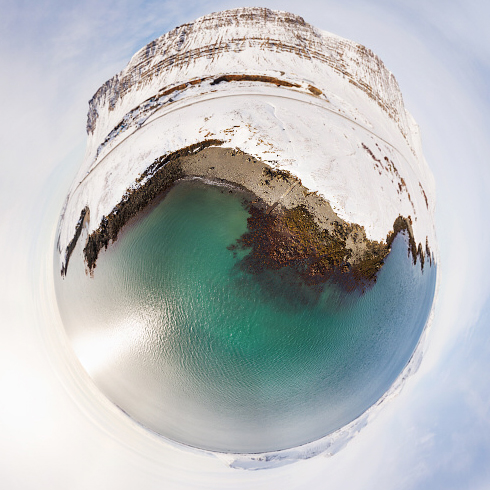
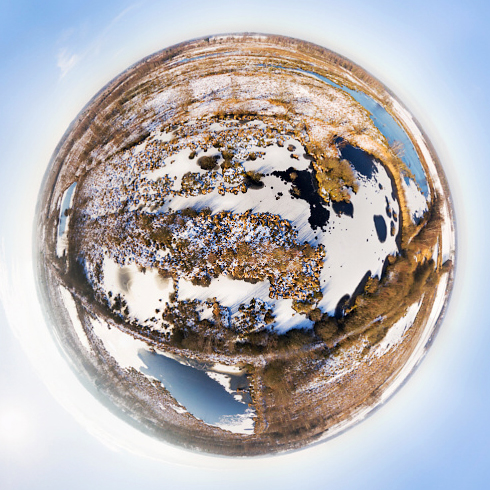
Little planets of Akrafell/Hvallfjördur (Iceland) and Haaksbergerveen (Netherlands) in winter. Click to enter the full panorama.
Personal safety and comfort
Of course, enabling safe flights is very important, but don’t forget your personal safety and comfort. I use warm clothing equipped for the weather conditions. Gloves should be warm, but still enable you to operate your remote controller and the touchscreen of your smartphone or tablet. Sunglasses can be handy with a low sun above snow. Drive and walk carefully when roads and paths are slippery. In Iceland (especially in winter) I check the weather forecast (en.vedur.is) and road conditions (road.is) several times a day. During winter conditions in Iceland, we always rent a four wheel drive car with studded tires and drive very carefully.
Hand launching and catching your drone
Snow (melting to water) may cover your lens and intrude your drone which can be dangerous. I always avoid taking off or landing in soft snow (or long wet grass, for the same reason). However, when there is a lot of snow it may be difficult to find a dry and flat location for take-off and landing. For this reason it may be a good idea to practice hand launch and catch of your drone. Warning: watch several videos about this (e.g. search on YouTube) before trying it yourself. I always launch and catch the drone well above my head and make sure to avoid the propellers, which can cause serious injury. When catching the drone after a flight, I bring it to a position about one meter away from me at an altitude above my head, then hover it there and walk to the drone (instead of flying to the place where I stand). Be very careful! A safer alternative is buying a landing pad.
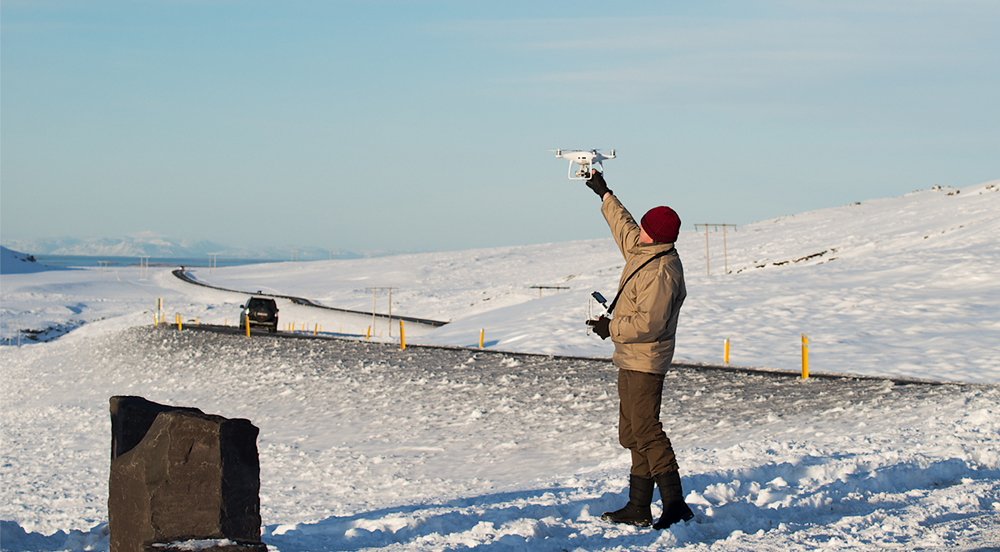
Be very careful while hand catching your drone and always do it above your head. Photo: Annie van Deursen (in Iceland).
Do not disturb wildlife
When flying your drone in a nature area, make sure not to disturb wildlife. When the landscape is covered with snow and lakes are frozen, supply of food and water is limited. Animals can be more vulnerable and should not waste their energy unnecessarily by fleeing from a drone. I carefully select my places for take-off and landing, avoiding places where animals are nearby. Avoid flying too low (in most cases I keep a minimum altitude of 50 meter) and do not fly towards groups of birds or other animals. Give animals their rest, especially in areas where snowfall and severe frost are rare like the Netherlands.
Straight down
The landscape is amazing in winter, but don’t forget to look down. I often prefer images taken (almost) straight down, as they often offer more opportunities to use my creativity. With a zoom lens (like the Mavic 2 Zoom) or telephoto lens (on the Mavic 3) you can catch a close look without flying too low.
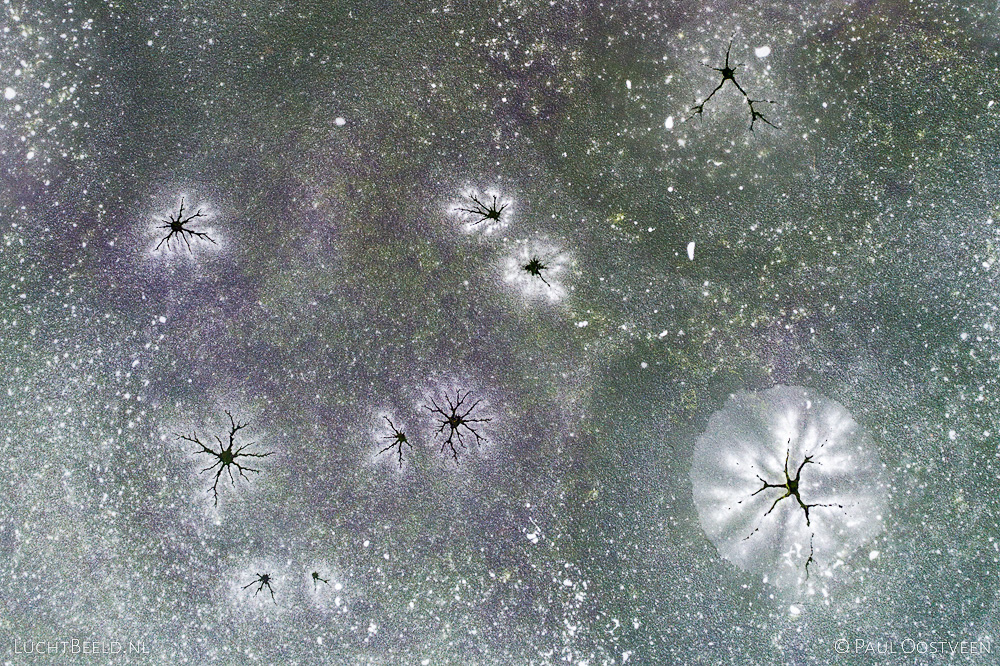
Galaxy. After a night of frost and a little bit of snow, a galaxy with black holes appeared in this small shallow lake.
Recommended drones
In the user manuals of many drones you will find that the recommended operating temperature is starting at freezing point (0°C or 32°F). Although
these drones often can be used in frost without problems, risks are higher and in case of an accident your insurance might refuse to pay.
Especially when flying in an area where people, traffic and/or property are around - or if you fly your drone professionally, I would suggest using a drone recommended for lower temperatures.
Many recent drones like the DJI Mavic 3, DJI Mini 3 and 4 Pro, DJI Air 3 and Autel EVO II (Pro) have a recommended operating temperature starting at -10°C (14°F).
Some of the standard controller however are only recommend above 0°C. For the DJI Smart Controller and RC Pro Controller, the recommended operating temperature is starting at -10°C. I currently use the Mavic 3 with RC Pro. Drones like the DJI Phantom, Air2S, Mini2, Autel EVO Nano/Light, Yuneec Typhoon H Plus and 520(E) are only recommended (by their manufacturers) at temperatures above 0°C (32°F).
Thank you for watching and reading! If you are going to fly in winter, I wish you a safe flight and great photos or video.
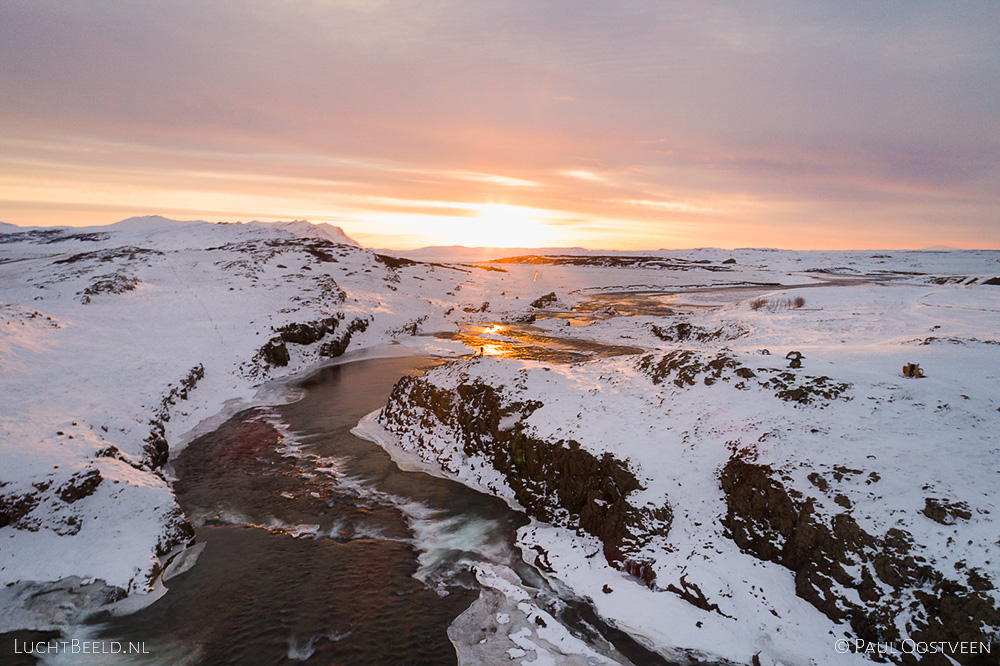
Sunset above waterfall Trollafossar in Iceland
Read my other tutorials:
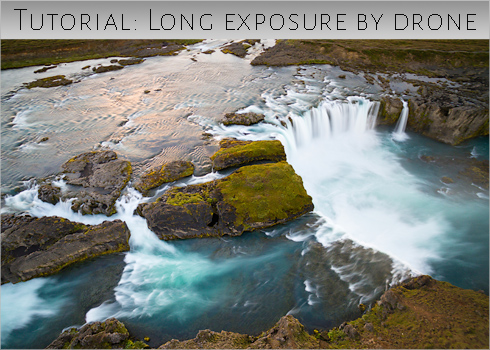
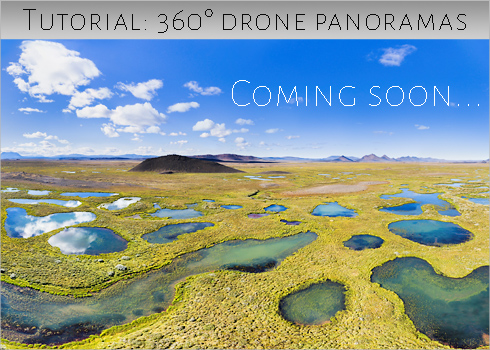
I will add more tutorials and blogs to my website during the coming years. Follow me on Instagram to stay informed:
 paul_oostveen
paul_oostveen
Are you inspired? (sponsored links)
Are you inspired and did you like my tutorial? Do you want to buy your own filters or drone equipment? Consider buying at online shops through the links provided below. If you use these links, I will receive a small commission if you make any order. It does not change your price or conditions, but will give me a modest reward for sharing this tutorial. Thank you.


